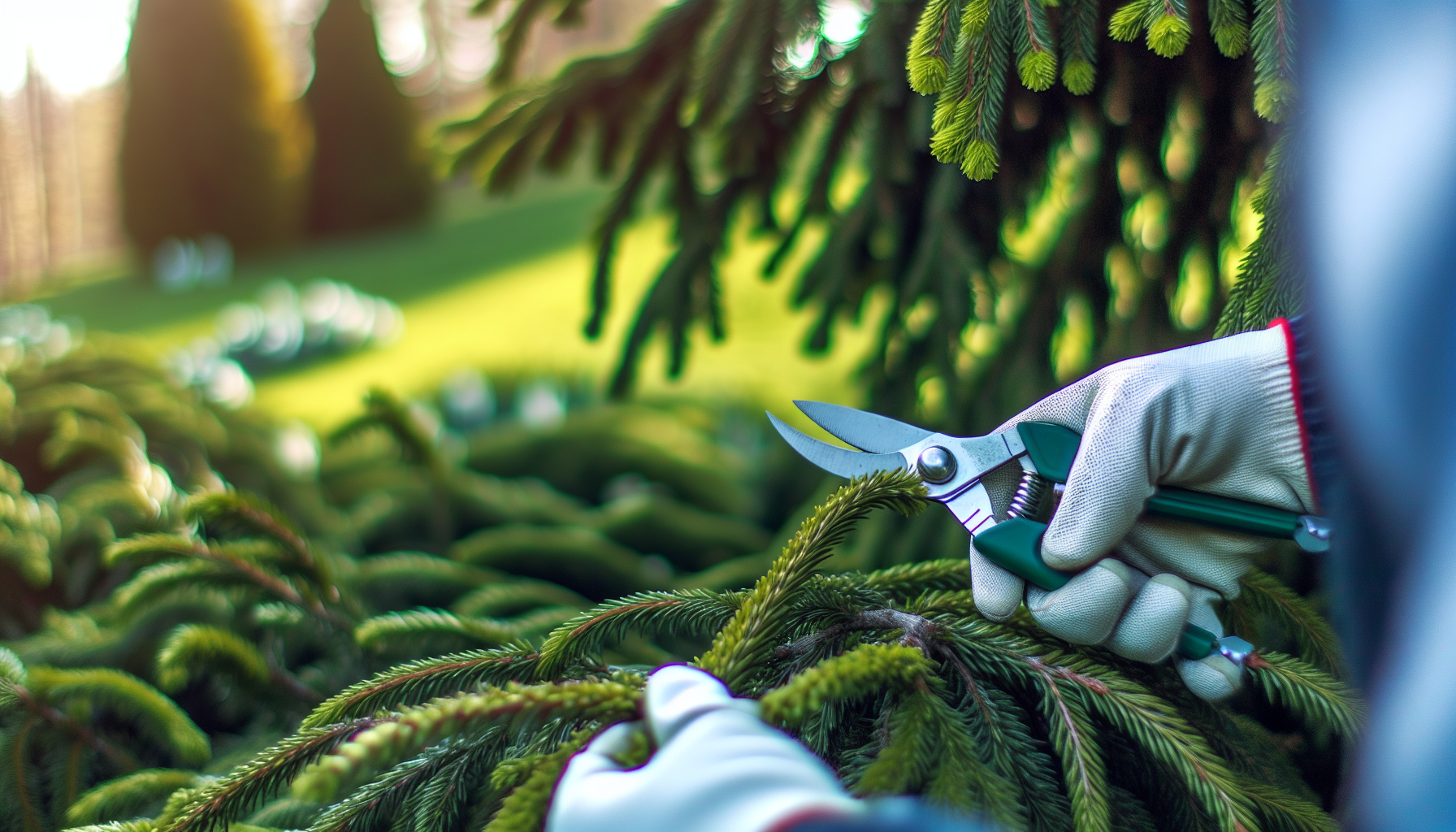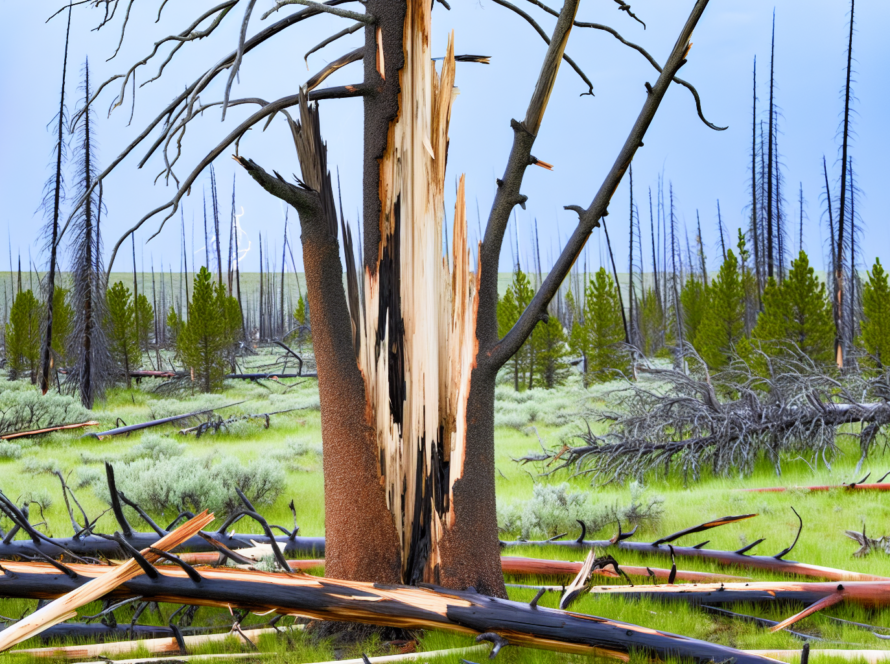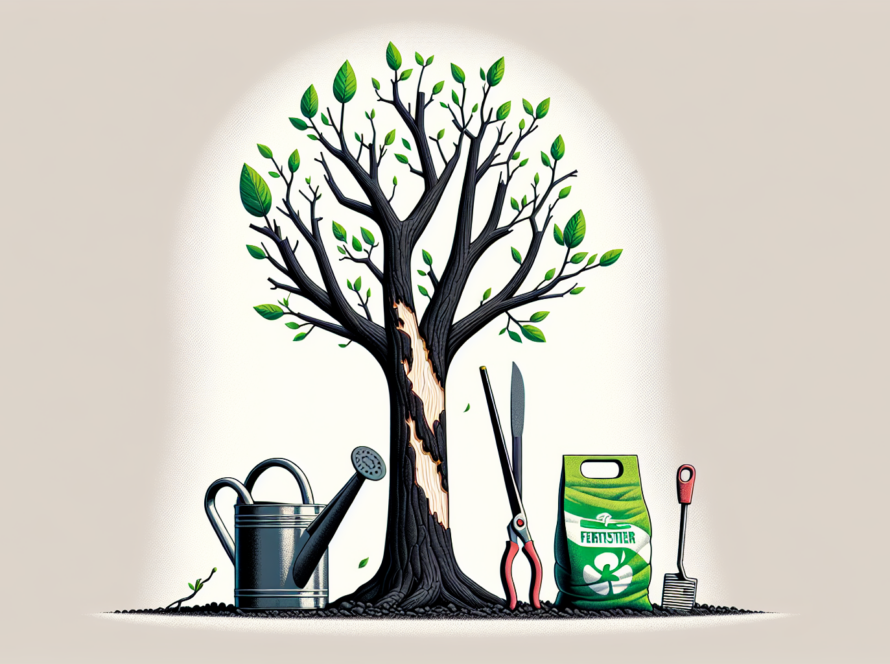Deciding when to prune evergreen trees can make the difference between vigorous growth and an unassuming silhouette. Typically, the best time for pruning evergreens is in early spring before the flush of new growth, or in late winter for structural adjustments. This critical timing ensures that your trees remain strong and retain their desired form throughout the year. In the following sections, we’ll delve deeper into specific tree types, techniques, and those insidious pruning pitfalls that one should avoid for a landscaped masterpiece.
Key Takeaways
Pruning evergreens is less about recovery and more about refining their shape and form, with the best time for pruning being early spring, or late winter for structural adjustments.
Specific pruning strategies are required for different types of evergreens, such as pines, spruces, firs, and junipers, with attention to their unique growth patterns and seasonal behaviors.
Pruning must always be purposeful and precise, using appropriate, clean, and sharp tools, and avoiding common mistakes such as over-pruning, incorrect timing, and damaging the branch collar.
Understanding Evergreen Trees: Growth and Pruning Needs

Evergreen trees, the stalwarts of the plant world, maintain their verdant splendor even when other trees stand bare. Unlike deciduous trees that shed their leaves annually, evergreens retain their foliage year-round, thanks to species like pines and cedars. Their growth rate, lower relative to their deciduous cousins, is a product of their unique strategies in biomass allocation and leaf characteristics. Pruning, then, is not about recovery but about refinement, shaping these majestic beings without marring their natural beauty. In addition to evergreen trees, evergreen hedges also contribute to the year-round greenery in many landscapes, providing an ideal environment for young trees to thrive.
The key to pruning evergreens lies in understanding their growth habits. Most evergreens feature a strong central leader and require little interference to thrive. When pruning is necessary, it’s to control height, encourage branch density, or maintain a particular shape, always respecting the tree’s inherent aesthetic. Knowing when and how to prune evergreens is essential for their overall health and appearance.
Conifers vs. Broadleaf Evergreens
Dive into the world of conifers, and you’ll find trees adorned with needle or scale-like leaves, producing seeds in cones, as opposed to the broader leaves of broadleaf evergreens. While the wide angles of attachment and dominant leaders of conifers emphasize their self-sufficient structure, requiring minimal training-type pruning, broadleaf varieties demand a more detailed approach to maintain their form and encourage flowering or fruiting,.
Consider the coniferous spruce trees, their needle-clad branches reaching skyward with little need for human intervention. Broadleaf evergreens, on the other hand, may call for a more meticulous touch to promote their best features, whether it’s the vibrant blooms of rhododendrons or the glossy leaves of hollies.
Whorled Branches vs. Random Branching Patterns
Understanding a tree’s branching pattern is as crucial as knowing an artist’s brushstrokes. Conifers like pines, spruces, and firs exhibit whorled branches, sprouting in circular patterns and typically experiencing a single growth flush each year. Evergreens with random branching patterns, such as yews and junipers, present a more unpredictable growth, requiring a tailor-made pruning strategy.
Whether you’re faced with the formal shape of a whorled branch, the wilder, random patterns, or a lateral branch, the goal remains the same: to prune trees in a way that enhances their natural form and vigor.
The Ideal Timeframe for Pruning Evergreen Trees

Timing is everything, particularly when it comes to pruning evergreens. The early spring season, just before the emergence of new buds, presents an opportune moment to shape your evergreen’s future growth. The late winter months also provide a window for structural pruning, setting the stage for the tree to heal and grow into its desired silhouette as the warmer weather arrives.
While corrective pruning can be approached throughout the year, the best time to prune is not during late summer and early fall. Pruning during this time could encourage new growth that may not withstand the harsher winter conditions.
Pruning Techniques for Common Evergreen Tree Types

Each evergreen species whispers its own pruning preferences, from the majestic pine to the robust juniper. Understanding these nuances ensures that evergreens are not just surviving but thriving under your care.
Pines
Pines stand tall with their whorled branches, and the art of pruning them is all about timing and technique. From late March to mid-May, these trees are primed for pruning, as their new growth candles reach out for the sun. By pinching or cutting these candles by a third to a half, you encourage a denser, more compact growth without compromising the tree’s natural grace,.
Be wary, though, of pruning the longest branches during summer, as this can leave unsightly stubs and harm the pine’s form.
Spruces and Firs
As the winter chill fades, the spruces and firs await their springtime trim. Pruning about 40% of the new growth in early spring or late winter helps maintain their pyramidal pride. Heading back pruning, where you cut back terminal growth to a bud or smaller branch, shapes the future of these evergreens, while fork pruning at the junction point ensures a natural, controlled growth.
Junipers
Junipers, with their intricate dead zones and spreading forms, require a gentle hand and a strategic eye. The planting season’s onset, between April and May, is the ideal time for pruning to avoid jeopardizing the plant’s winter hardiness. While the tips of branches on spreading junipers can be pruned annually for compactness, it’s crucial to steer clear of the dead zone at the plant’s center, as this will result in bare spots that won’t regenerate.
Best Practices for Pruning Evergreen Trees

Pruning evergreens is akin to sculpting a masterpiece; every cut must be deliberate and precise. Proper cuts should always be made outside the branch collar without damaging this vital area, angled just so, between 45 to 60 degrees relative to the branch bark ridge. Tools are the extension of the pruner’s intent, and as such, should be kept disinfected, particularly when dealing with diseased branches, to prevent infecting the tree or its companions.
The three-cut method is a safeguard against the bark tearing, crucial when dealing with branches over an inch thick. This technique ensures that the final, defining cut is made outside the branch collar for the cleanest healing. Avoiding common missteps, such as the use of wound dressing on cuts or pruning without purpose, is imperative to maintain the tree’s health and visual appeal.
Pruning Evergreen Shrubs: Timing and Techniques

Evergreen shrubs, with their lush foliage and versatile forms, also benefit from timely and thoughtful pruning. To prune evergreen shrubs, early spring or mid-summer are ideal times for this task, providing a balance that allows for healing and rejuvenation. Selective pruning, the art of cutting one branch at a time to guide the plant’s growth, preserves the shrub’s natural shape and essence.
Shaping shrubs into unnatural forms may seem creative, but it often leads to a loss of character and health. Instead, embrace the plant’s inherent design, enhancing its role in accentuating home foundations and garden landscapes. Tools like hand clippers and loppers are the preferred instruments for this delicate work, ensuring precision and care with every snip.
Maintenance Pruning: Keeping Your Evergreens Healthy
The well-being of evergreens is bolstered by maintenance pruning, a practice that not only enhances their appearance but extends their vitality. Removing weak, damaged, or dead branches prevents further harm and stimulates a fresh burst of growth, improving both sunlight penetration and air circulation. By guiding the direction of growth, maintenance pruning lays the groundwork for a tree’s stability, safety, and overall health.
Regular attention to pruning not only keeps evergreens looking their best but also contributes to the property’s curb appeal and value. Dead, diseased, or broken branches should be pruned away promptly, regardless of season, to preserve the plant’s health. Annual maintenance also prevents the landscape from becoming overgrown, ensuring harmony and space for all plants to flourish.
Avoiding Common Pruning Mistakes
Even with the best intentions, pruning can go awry. Removing too much foliage in one session can leave evergreens stressed and vulnerable, undermining their ability to recover and resist disease. Light pruning, the thoughtful removal of individual branches, is generally more beneficial than the indiscriminate approach of shearing, which can reduce light penetration and yield an unnatural appearance.
Timing is also a factor in pruning success. Trimming during the growing season can strip the tree of vital leaves, weakening it and exposing the bark to potential sunscald. It’s essential to prune with a clear purpose, always cutting back to healthy wood and avoiding the lifeless core of the tree, where no new growth can emerge.
Tools for Successful Evergreen Tree Pruning
The craftsman is only as good as their tools, and the same holds true for the gardener. A selection of pruning shears, garden pruners, tree loppers, hedge shears, and pruning saws are indispensable allies in the quest for well-pruned evergreens. Dull tools can mangle branches, leading to larger wounds that compromise the tree’s health, so it’s vital to keep cutting instruments sharp and clean.
Specific tools cater to different needs. Some recommended tools for gardening include:
Non-stick coated loppers, which are a boon when dealing with sappy pines
Bypass pruners, which provide the precision needed for intricate work on arborvitaes
Titanium Coated Bypass Pruners and Compound-action Loppers, with their SK-5 high carbon steel blades, which are highly recommended for their durability and ease of use.
Summary
To harness the full potential of your evergreen trees and shrubs, remember that pruning is a nuanced art. Whether you’re shaping the mighty pine or refining the lush juniper, it’s about respecting the natural form, understanding the species’ needs, and acting with precision. Embrace the best practices shared here, and your evergreens will reward you with robust health and timeless beauty.
Frequently Asked Questions
Is it OK to trim evergreens in the fall?
It is not recommended to trim evergreens in the fall because fall-pruned evergreens are more susceptible to winter injury and pruning at this time can stimulate new growth that may not harden off before winter. (Based on multiple sources)
Are you supposed to cut bottom branches evergreen trees?
It is generally not recommended to cut bottom branches of evergreen trees, as it can negatively impact the tree’s health and aesthetics. Removing healthy lower branches can increase the risk of decay and stress the tree.
Can you prune evergreens in winter?
It’s best to prune evergreens in late winter or early spring when they are still dormant, as this helps prevent tip burn and allows for easier visibility of the plant’s structure. Some evergreens, like spruce and arborvitae, may benefit from pruning during this time.
Can I use shears to prune my evergreen trees?
It’s best to use selective pruning techniques with hand clippers or loppers for evergreen trees to maintain their natural form and prevent foliage drop. Using shears for trees can lead to undesirable results.
How much of an evergreen tree can I prune at once?
You should avoid removing more than one-third of an evergreen tree’s foliage during a pruning session to prevent stress and potential health issues. Pruning more than that can be harmful to the tree.




